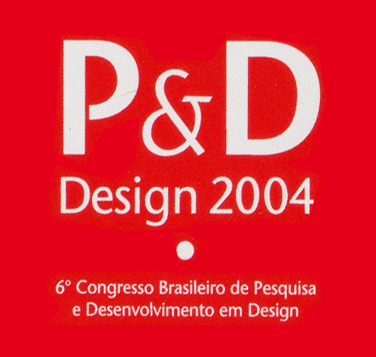
6º Congresso Brasileiro de Pesquisa e Desenvolvimento em Design
Faap — São Paulo (SP)
Novembro/2004
Comunicação em Design
Comunicação Visual, Design de Interiores e Urbano
Design Digital e Multimeios
Um Estudo sobre o Design das Representações Gráficas no Site do Sítio do Pica-pau Amarelo
Design do Produto
Design Gráfico
O nascimento do design gráfico: Tipografia ou Futurismo
Design Informacional
Proposta de Identidade Visual e Design da interface para o Projeto da biblioteca de materiais -Materioteca do Centro Universitário Feevale
Design Têxtil e de Vestuário
Moda e estética de Lampião
Eco-Design
Ensino e Pesquisa
Ergonomia Ambiental e de Sistemas
Ergonomia do Produto
Ergonomia e HCI
Ergonomia Informacional
Fundamentos Teóricos
O objeto – imagem como signo da promoção social de consumo
Gestão em Design
A nova objetividade do Desenho Industrial: das necessidades sociais às virtualidades do lucro
História do Design
A evolução da habitação e sua paisagem doméstica
O desenvolvimento do design de bicicletas reclinadas no Brasil
Materiais e Processos em Design do Produto
Metodologia do Projeto
Semiótica em Design
Livro: amor e desafeto
6º Congresso Brasileiro de Pesquisa e Desenvolvimento em Design
Faap — São Paulo (SP)
Novembro/2004
Design Gráfico
As apropriações do vernacular pela comunicação gráfica
The vernacular appropriations by the visual communication
Resumo
Abstract
Referências bibliográficas
- BLACKWELL, Lewis; BRODY, Neville. Gl: new dimensions in graphic design. New York: Rizzoli, 1996.
- BLAUVELT, Andrew. In and around: Cultures of design and the design of cultures. Emigre, Sacramento (USA): n. 33, p. 2-23, 1995.
- CAUDURO, Flávio Vinicius. Design Gráfico & Pós-Modernidade. Revista FAMECOS: mídia, cultura e tecnologia. Faculdade de Comunicação Social, PUCRS. Porto Alegre: n. 13, p. 127-139, dez. 2000.
- CONNOR, Steven. Cultura pós-moderna: Introdução às teorias do contemporâneo. São Paulo: Loyola, 1992.
- COUPLAND, Ken. Making Faces. How, Cincinnati: v. 13, n. 1, p. 76-83, jan./fev. 1998.
- FARRELLY, Liz. Herbert Spencer: Traces of man. Eye: The International Review of Graphic Design, London: v. 1, n. 3, p. 64-69, abr./maio 1991.
- FARIAS, Priscila. Tipografia digital. Rio de Janeiro: 2AB, 2000 a.
FARIAS, Priscila. Seu Juca, letrista pernambucano. Tupigrafia. São Paulo: Bookmakers, 2000 b.
FARIAS, Priscila. A Arte Tipográfica de Seu Juca & Fragmentos Vernaculares (texto de introdução do calendário). Recife: Congresso da SBDI, set. 2003.
- FEATHERSTONE, Mike. Cultura de consumo e pós-modernismo. São Paulo: Nobel, 1995.
- HALL, Peter; BIERUT, Michel. Tibor Kalman: perverse optimist. London: Booth-Clibborn, 1998.
- KEEDY, Jeffery. I like the vernacular...not. Looking Closer 2: critical writings in graphic design. New York: Allworth Press and American Institute of Graphic Arts, p. 101-108, 1994.
- LEON, Ethel. Altas, longas, redondas ou vazadas: Uma mostra das letras populares brasileiras em ensaio fotográfico de Edson Meirelles. Design Belas Artes, São Paulo: publ. Curso de Desenho Industrial da Faculdade de Belas Artes de São Paulo, set. 2000.
- LUPTON, Ellen. The academy of deconstructed design. Eye: The International Review of Graphic Design, London: v. 1, n. 3, p. 44-63, 1991.
LUPTON, Ellen. Mixing messages: graphic design in contemporary culture. New York: Princeton Architectural Press, 1996.
- MAFFESOLI, Michel. A contemplação do mundo. Porto Alegre: Artes e Ofícios, 1995.
- MORETTO, Paulo. Tipografia brasilis. Reportagem publicada originalmente em PROJETODESIGN, ed. 255, maio 2001. Disponível em: http://www.revprojeto.com.br. Acesso em: 25 out. 2003.
- NEWLYN, Miles. Missionary font. Disponível em:http://www.emigre.com/EfolMishtml Acesso em março 2002
- PLAP. Peças gráficas desenvolvidas pelo núcleo de design Nú-dës. Disponível em http://www.nudes.com.br/nubatente/plap. Acesso em: 20 julho 2003.
- ROCHA, Cláudio; MARCO, Tony. Tupigrafia. São Paulo: Bookmakers, 2000.
- SCHWARTZ, Christian. The story of Los Feliz. Disponível em: http://www.emigre.com/EF.feature.php?di=102. Acesso jun. 2003.
- VENTURI, Robert; IZENOUR, Steven; SCOTT BROWN Denise. Aprendiendo con Las Vegas. Barcelona: Gustavo Gili, 1998.
- WALTON, Roger. Typographic: Three global vision. London: Castle House, 1998.
